
Timeline of peptic ulcer disease and Helicobacter pylori
Encyclopedia

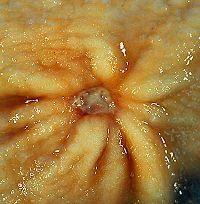
This is a timeline of the events relating to the discovery that peptic ulcer disease is caused by H. pylori.
Barry Marshall
Barry James Marshall, AC, FRS, FAA is an Australian physician, Nobel Prize laureate in Physiology or Medicine, and Professor of Clinical Microbiology at the University of Western Australia. Marshall is well-known for proving that the bacterium Helicobacter pylori Barry James Marshall, AC, FRS, FAA...
and Robin Warren
Robin Warren
John Robin Warren AC is an Australian pathologist, Nobel Laureate and researcher who is credited with the 1979 re-discovery of the bacterium Helicobacter pylori, together with Barry Marshall.- Life and career :...
were awarded the Nobel Prize in Physiology or Medicine
Nobel Prize in Physiology or Medicine
The Nobel Prize in Physiology or Medicine administered by the Nobel Foundation, is awarded once a year for outstanding discoveries in the field of life science and medicine. It is one of five Nobel Prizes established in 1895 by Swedish chemist Alfred Nobel, the inventor of dynamite, in his will...
for their discovery that peptic ulcer disease (PUD) was primarily caused by Helicobacter pylori
Helicobacter pylori
Helicobacter pylori , previously named Campylobacter pyloridis, is a Gram-negative, microaerophilic bacterium found in the stomach. It was identified in 1982 by Barry Marshall and Robin Warren, who found that it was present in patients with chronic gastritis and gastric ulcers, conditions that were...
, a bacterium with affinity for acidic environments, such as the stomach
Stomach
The stomach is a muscular, hollow, dilated part of the alimentary canal which functions as an important organ of the digestive tract in some animals, including vertebrates, echinoderms, insects , and molluscs. It is involved in the second phase of digestion, following mastication .The stomach is...
. As a result, PUD that is associated with H. pylori is currently treated with antibiotic
Antibiotic
An antibacterial is a compound or substance that kills or slows down the growth of bacteria.The term is often used synonymously with the term antibiotic; today, however, with increased knowledge of the causative agents of various infectious diseases, antibiotic has come to denote a broader range of...
s used to eradicate the infection. For 30 years prior to their discovery, it was widely believed that PUD was caused by excess acid
Acid
An acid is a substance which reacts with a base. Commonly, acids can be identified as tasting sour, reacting with metals such as calcium, and bases like sodium carbonate. Aqueous acids have a pH of less than 7, where an acid of lower pH is typically stronger, and turn blue litmus paper red...
in the stomach
Stomach
The stomach is a muscular, hollow, dilated part of the alimentary canal which functions as an important organ of the digestive tract in some animals, including vertebrates, echinoderms, insects , and molluscs. It is involved in the second phase of digestion, following mastication .The stomach is...
. During this time, acid control was the primary method of treatment for PUD, to only partial success; among other effects, it is now known that acid suppression alters the stomach milieu to make it less amenable to H. pylori infection.
Background
Before the 1950s, there were many microbiological descriptions of bacteria in the stomach and in gastric acid secretions, lending credence to both the infective theory and the hyperacidity theory as being causes of peptic ulcer disease. A single study, conducted in 1954, did not find evidence of bacteria on biopsies of the stomach stained traditionally; this effectively established the acid theory as dogmaDogma
Dogma is the established belief or doctrine held by a religion, or a particular group or organization. It is authoritative and not to be disputed, doubted, or diverged from, by the practitioners or believers...
. This paradigm was altered when Warren and Marshall effectively proved Koch's postulates
Koch's postulates
Koch's postulates are four criteria designed to establish a causal relationship between a causative microbe and a disease. The postulates were formulated by Robert Koch and Friedrich Loeffler in 1884 and refined and published by Koch in 1890...
for causation of PUD by H. pylori through a series of experiments in the 1980s; however, an extensive effort was required to convince the medical community of the relevance of their work. Now, all major gastrointestinal societies agree that H. pylori is the primary nondrug cause of PUD worldwide, and advocate its eradication as essential to treatment of gastric and duodenal ulcers. Additionally, H. pylori has been associated with lymphomas
Gastric lymphoma
Primary gastric lymphoma is an uncommon condition, accounting for less than 15% of gastric malignancies and about 2% of all lymphomas. However, the stomach is a very common extranodal site for lymphomas...
and adenocarcinomas of the stomach, and has been classified by the World Health Organization
World Health Organization
The World Health Organization is a specialized agency of the United Nations that acts as a coordinating authority on international public health. Established on 7 April 1948, with headquarters in Geneva, Switzerland, the agency inherited the mandate and resources of its predecessor, the Health...
as a carcinogen
Carcinogen
A carcinogen is any substance, radionuclide, or radiation that is an agent directly involved in causing cancer. This may be due to the ability to damage the genome or to the disruption of cellular metabolic processes...
. Advances in molecular biology
Molecular biology
Molecular biology is the branch of biology that deals with the molecular basis of biological activity. This field overlaps with other areas of biology and chemistry, particularly genetics and biochemistry...
in the late 20th century led to the sequencing of the H. pylori genome, resulting in a better understanding of virulence factor
Virulence factor
Virulence factors are molecules expressed and secreted by pathogens that enable them to achieve the following:* colonization of a niche in the host...
s responsible for its colonization and infection, on the DNA level.
Pre-20th century

- HippocratesHippocratesHippocrates of Cos or Hippokrates of Kos was an ancient Greek physician of the Age of Pericles , and is considered one of the most outstanding figures in the history of medicine...
first describes gastric symptoms. - AvicennaAvicennaAbū ʿAlī al-Ḥusayn ibn ʿAbd Allāh ibn Sīnā , commonly known as Ibn Sīnā or by his Latinized name Avicenna, was a Persian polymath, who wrote almost 450 treatises on a wide range of subjects, of which around 240 have survived...
notes the relationship between gastric pain and mealtimes.
1586
- Marcellus Donatus of Mantua performs autopsies and describes gastric ulcers.
1688
- Johannes von Murault observes duodenal ulcers.
1728
- Stahl hypothesizes that some feverFeverFever is a common medical sign characterized by an elevation of temperature above the normal range of due to an increase in the body temperature regulatory set-point. This increase in set-point triggers increased muscle tone and shivering.As a person's temperature increases, there is, in...
s are related to gastric inflammation and ulceration.
1761
- Pain is associated with stomach ulcers.
1799
- Matthew BaillieMatthew BaillieMatthew Baillie was a Scottish physician and pathologist.-Life:...
publishes a description of ulcers.
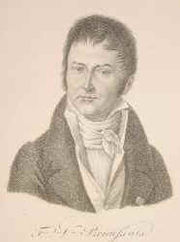
- BroussaisFrançois-Joseph-Victor BroussaisFrançois-Joseph-Victor Broussais was a French physician.-Life:From his father, who was also a physician, he received his first instructions in medicine, and he studied for some years at a college in Dinan named after him, "Collège François Broussais"...
discovers that if acute gastritisGastritisGastritis is an inflammation of the lining of the stomach, and has many possible causes. The main acute causes are excessive alcohol consumption or prolonged use of nonsteroidal anti-inflammatory drugs such as aspirin or ibuprofen. Sometimes gastritis develops after major surgery, traumatic...
is untreated, it can become chronic.
1821
- Nepveu argues for a relationship between gastritis and gastric cancer.
1822
- William BeaumontWilliam BeaumontWilliam Beaumont was a surgeon in the U.S. Army who became known as the "Father of Gastric Physiology" following his research on human digestion.-Early life:...
first demonstrates the acidity of the stomach and a relationship between acid levels and mood.
1868
- KussmaulAdolph KussmaulAdolph Kussmaul was a German physician and a leading clinician of his time. He was born as the son and grandson of physicians at Graben near Karlsruhe and studied at Heidelberg. He entered the army after graduation and spent two years as an army surgeon...
suggests using bismuthBismuthBismuth is a chemical element with symbol Bi and atomic number 83. Bismuth, a trivalent poor metal, chemically resembles arsenic and antimony. Elemental bismuth may occur naturally uncombined, although its sulfide and oxide form important commercial ores. The free element is 86% as dense as lead...
compounds, an antibacterial agent, to treat peptic ulcers (bismuth subsalicylateBismuth subsalicylateBismuth subsalicylate, with a nominal chemical formula of C7H5BiO4, It is a colloidal substance obtained by hydrolysis of bismuth salicylate . The actual structure is unknown and the formulation is only approximate. Recent evidence indicates that it is composed of a bismuth oxide core structure...
has since been used in many commercial drugs, including Pepto Bismol as part of antibacterial H. pylori treatment). The antibacterial properties of bismuth were not known until much later.
1875
- G. Bottcher and M. Letulle hypothesize that ulcers are caused by bacteriaBacteriaBacteria are a large domain of prokaryotic microorganisms. Typically a few micrometres in length, bacteria have a wide range of shapes, ranging from spheres to rods and spirals...
.
1880
- J. Cohnheim suggests that ulcers may be caused by chemical factors.
1881
- KlebsEdwin KlebsTheodor Albrecht Edwin Klebs was a German-Swiss pathologist. He is mainly known for his work on infectious diseases. He is the father of Arnold Klebs.-Life:...
notes the presence of bacteria-like organisms in the lumenLumen (anatomy)A lumen in biology is the inside space of a tubular structure, such as an artery or intestine...
of the gastric glands.
1889
- Walery JaworskiWalery JaworskiWalery Jaworski , was one of the pioneers of gastroenterology in Poland.In 1899 he described bacteria living in the human stomach that he named "Vibrio rugula". He speculated that they were responsible for stomach ulcers, gastric cancer and achylia. It was one of the first observations of...
describes spiral organisms in sediment washings of humans. He suggests these organisms might be involved with gastric disease.
1892
- Giulio BizzozeroGiulio BizzozeroGiulio Bizzozero was an Italian doctor and medical researcher. He is known as the original discoverer of Helicobacter pylori, the bacteria which is responsible for peptic ulcer disease...
observes spiral organisms in the stomach of dogs.

- Saloon finds spirochetes in the stomachs of cats and mice.
1900–1950
1905- F. Reigel suggests that ulcers are caused by excess acid.

- Krienitz finds bacteria in the stomach of people with gastric cancer.
- Turck feeds dogs Bacillus coli and produces ulcers.
1907
- Berkley Moynihan suggests that acid is a cause of ulcers.
1910
- Schwartz publishes the excess acid theory of the ulcer, coining the famous phrase "no acid, no ulcer."
- Gibelli claims to be unable to reproduce Turck's study where he artificially created ulcers by feeding dogs bacteria.
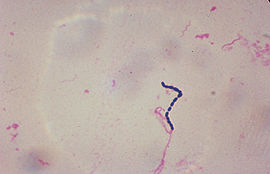
- Rosenow suggests that streptococci produce ulcers.
1915
- AntacidAntacidAn antacid is a substance which neutralizes stomach acidity.-Mechanism of action:Antacids perform a neutralization reaction, increasing the pH to reduce acidity in the stomach. When gastric hydrochloric acid reaches the nerves in the gastrointestinal mucosa, they signal pain to the central nervous...
s are first recommended for the treatment of PUD. - Bacteria are associated with PUD, but it is assumed that the bacteria reside in the mouth.
1919
- Kasai and Kobayashi isolate spirochetes in cats and transmit them to rabbits, producing ulcers.
1921
- Luger discovers spirochetes in the gastric juice, and associates their presence with gastric cancer.
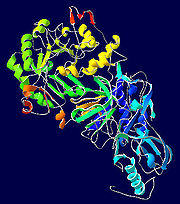
- Luck and Seth discover ureaseUreaseUrease is an enzyme that catalyzes the hydrolysis of urea into carbon dioxide and ammonia. The reaction occurs as follows:In 1926, James Sumner showed that urease is a protein. Urease is found in bacteria, yeast, and several higher plants. The structure of urease was first solved by P.A...
in the human stomach, which they believe is naturally occurring. It is now known that one of the virulence factors of H. pylori is the urease enzyme, which splits ureaUreaUrea or carbamide is an organic compound with the chemical formula CO2. The molecule has two —NH2 groups joined by a carbonyl functional group....
into ammoniaAmmoniaAmmonia is a compound of nitrogen and hydrogen with the formula . It is a colourless gas with a characteristic pungent odour. Ammonia contributes significantly to the nutritional needs of terrestrial organisms by serving as a precursor to food and fertilizers. Ammonia, either directly or...
1925
- Hoffman injects a small sample from a human with PUD into a guinea pig, producing ulcers, and isolates a bacterium which he believes caused the ulcers.
1936
- First edition of the Russian Large Medical Encyclopedia suggests infection is one of the causes of PUD.
1939
- A. Stone Freedberg begins a study to look for bacteria in the human stomach at Beth Israel HospitalBeth Israel HospitalBeth Israel Hospital may refer to:*Beth Israel Deaconess Medical Center in Boston*Beth Israel Medical Center in Manhattan*Beth Israel Medical Center in Newark...
. He finds H. pylori. It is rumored that others cannot reproduce the results, although no negative results are published. - James Doenges describes spirochetes in autopsies.
1940
- Freedberg and Baron observe spirochetes in autopsies. Freedberg abandons his research, however, after his boss advises him to move to another subject. In 2005, Marshall speculates that Freedberg would have won the Nobel Prize in 1951 had he continued his work.
1948
- Fitzgerald and Murphy hypothesize that PUD is caused by acid eating away mucosa, and demonstrate the effectiveness of ureaUreaUrea or carbamide is an organic compound with the chemical formula CO2. The molecule has two —NH2 groups joined by a carbonyl functional group....
as a treatment for PUD.
1950–1970
1951- J. Allende publishes a book describing the treatment of gastric ulcers with penicillinPenicillinPenicillin is a group of antibiotics derived from Penicillium fungi. They include penicillin G, procaine penicillin, benzathine penicillin, and penicillin V....
.
1953
- Dintzis and Hastings are able to stop ureaseUreaseUrease is an enzyme that catalyzes the hydrolysis of urea into carbon dioxide and ammonia. The reaction occurs as follows:In 1926, James Sumner showed that urease is a protein. Urease is found in bacteria, yeast, and several higher plants. The structure of urease was first solved by P.A...
production in mice with antibioticAntibioticAn antibacterial is a compound or substance that kills or slows down the growth of bacteria.The term is often used synonymously with the term antibiotic; today, however, with increased knowledge of the causative agents of various infectious diseases, antibiotic has come to denote a broader range of...
s, suggesting a relationship between urease and a bacterial infection.
1954
- Palmer publishes a study which finds no bacteria in the human stomach. He concludes earlier discoveries were a result of contamination. Unfortunately, he chooses not to use a silver stainStainA stain is a discoloration that can be clearly distinguished from the surface, material, or medium it is found upon. Stains are caused by the chemical or physical interaction of two dissimilar materials...
ing method, which will be later used to reveal H. pylori by Warren and Marshall.
1955
- Tarnopolskaya observes that penicillin seems to cure some peptic ulcers.
- Moutier and Cornet suggest treating gastritis with antibiotics.
- Kornberg and Davies observe that antibiotics reduce urease in cats.

- Charles Lieber and Andre Lefèvre discover that antibiotics reduce gastric urea to ammoniaAmmoniaAmmonia is a compound of nitrogen and hydrogen with the formula . It is a colourless gas with a characteristic pungent odour. Ammonia contributes significantly to the nutritional needs of terrestrial organisms by serving as a precursor to food and fertilizers. Ammonia, either directly or...
conversion.
1958
- Gordon observes that penicillin cures some peptic ulcers.
- John LykoudisJohn LykoudisJohn Lykoudis was a general practitioner in Greece who treated patients suffering from peptic ulcer disease with antibiotics long before it was commonly recognized that bacteria were a dominant cause for the disease....
successfully treats his own gastroenteritisGastroenteritisGastroenteritis is marked by severe inflammation of the gastrointestinal tract involving both the stomach and small intestine resulting in acute diarrhea and vomiting. It can be transferred by contact with contaminated food and water...
with antibiotics. - Lieber and Lefèvre present their results at the World Congress of Gastroenterology in Washington. It is not well received because of the widespread belief that bacteria cannot survive in the human stomach, due to Palmer.
1959
- Lieber and Lefèvre publish a follow-up study demonstrating that antibiotics prevent the conversion of urea to ammonia in the human stomach.
- Conway et al. call into question the extent of urease produced by bacteria in mice, as an argument against the bacterial theory of PUD.
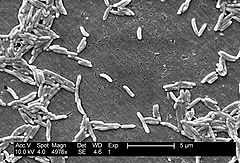
- Vital and Orrego observe CampylobacterCampylobacterCampylobacter is a genus of bacteria that are Gram-negative, spiral, and microaerophilic. Motile, with either unipolar or bipolar flagella, the organisms have a characteristic spiral/corkscrew appearance and are oxidase-positive. Campylobacter jejuni is now recognized as one of the main causes...
-like organisms in the stomachs of cats and dogs. - Lykoudis is awarded a Greek patent (#22,453) for his antibiotic treatment of PUD.
1962
- Susser and Stein publish a paper identifying a cohort phenomenonCohort effectThe term cohort effect is used in social science to describe variations in the characteristics of an area of study over time among individuals who are defined by some shared temporal experience or common life experience, such as year of birth, or year of exposure to radiation.Cohort effects are...
of PUD in England. This is taken as evidence for stress causing PUD.
1964
- Lykoudis presents his antibiotic treatment for PUD at a meeting of the Medico-Surgical Society in Greece. He is largely shunned by the medical establishment.
1966
- Lykoudis' manuscript is rejected by the Journal of the American Medical AssociationJournal of the American Medical AssociationThe Journal of the American Medical Association is a weekly, peer-reviewed, medical journal, published by the American Medical Association. Beginning in July 2011, the editor in chief will be Howard C. Bauchner, vice chairman of pediatrics at Boston University’s School of Medicine, replacing ...
.
1967
- Susumu Ito describes Campylobacter-like organisms attached to a gastric epithelial cell.
1968
- Lykoudis is fined 4,000 drachmas for treating PUD patients with his treatment, which includes antibiotics.
1970–21st century
1971- Howard Steer observes H. pylori from biopsies of a patient with ulcers.
1972
- The first report of successfully using furazolidoneFurazolidoneFurazolidone is a nitrofuran antibacterial. It is marketed by Roberts Laboratories under the brand name Furoxone and by GlaxoSmithKline as Dependal-M.-Uses:It is used to treat diarrhoea and enteritis caused by bacteria or protozoan infections....
(an antibacterial agent) to treat PUD in China.
1974
- Morozov observes H. pylori; he does not connect this discovery to PUD.
- A well regarded study of PUD is published which does not mention bacteria.

- Steer and Colin-Jones publish their results regarding H. pylori and its relation to PUD. They decide that it was PseudomonasPseudomonasPseudomonas is a genus of gammaproteobacteria, belonging to the family Pseudomonadaceae containing 191 validly described species.Recently, 16S rRNA sequence analysis has redefined the taxonomy of many bacterial species. As a result, the genus Pseudomonas includes strains formerly classified in the...
, a contaminant, and not related to PUD.
1978
- At a meeting of the American Gastroenterology Association in Las Vegas, several papers are presented which suggest that acid control via H2 blockers is ineffective at curing PUD.
1979
- Ramsey publishes a study demonstrating that bismuth can help eradicate PUD. Bismuth is an antibacterial agent, although this is not recognized by Ramsey.
- J. Robin Warren first observes H. pylori in a gastric biopsy.
- Fung, Papadimitriou, and Matz observe H. pylori.
1981
- Yao Shi observes bacteria in the stomach, but he believes they are passing through the stomach and not colonizing it.
- July: Barry Marshall joins gastroenterology division of Royal Perth HospitalRoyal Perth HospitalRoyal Perth Hospital is an 855-bed teaching hospital located on the northeastern edge of the CBD of Perth, Western Australia . Royal Perth Hospital also has specialised rehabilitation facilities at Shenton Park.-History:...
and meets Robin Warren - October: Marshall and Warren successfully treat their first PUD patient with antibiotics.
1982
- Satoha et al. find evidence for an infectious cause of ulcers in rats.
- Marshall and Warren begin their first study to determine the relationship between H. pylori and PUD.
- First successful culturing of H. pylori performed; it occurs almost by accident.
- October: Marshall discovers the bacteria he is investigating are not campylobacteria, by looking at electron micrographs.
- October 2: Marshall presents his and Warren's results at a local College of Physicians meeting. He meets with criticism, which Marshall later admits was well-founded (at least in part).

- January: Two letters authored by Warren and Marshall, respectively, are sent to The Lancet describing their results.
- February: Gastroenterological Society of Australia rejects Marshall's abstract to present his research at their yearly conference. They deem it in the bottom 10% of papers submitted. The same abstract is accepted for presentation at a Campylobacter workshop in Brussels.
- April: Marshall and Ian Hislop begin a study to compare bismuth treatment with cimetidineCimetidineCimetidine INN is a histamine H2-receptor antagonist that inhibits the production of acid in the stomach. It is largely used in the treatment of heartburn and peptic ulcers. It is marketed by GlaxoSmithKline under the trade name Tagamet...
. The study is abandoned because it is inconclusive. - June: Warren and Marshall's letter appears in The Lancet.
- September: H. pylori is observed in patients outside of Australia.
- After the appearance of the letters in The Lancet, groups around the world begin isolating H. pylori.
1984
- A paper describing Marshall and Warren's results is accepted by the Gastroenterological Society of Australia for presentation.
- Marshall and Goodwin attempt to infect pigs with H. pylori in an attempt to demonstrate that it causes PUD. The experiment fails.
- Marshall and Warren's paper is accepted by The Lancet in May and published in June. Many reviewers dislike the paper.
- McNulty and Watson are able to reproduce Marshall and Warren's results.
- June 12: Marshall intentionally consumes H. pylori and becomes ill. He takes antibiotics and is relieved of his symptoms.
- The National Health and Medical Research CouncilNational Health and Medical Research CouncilThe National Health and Medical Research Council is Australia's peak funding body for medical research, with a budget of roughly 700 million dollars a year...
of Australia fully funds Marshall's research into H. pylori. - A study is published in China about the effectiveness of treating PUD with an antibacterial agent.
- July 31: The New York TimesThe New York TimesThe New York Times is an American daily newspaper founded and continuously published in New York City since 1851. The New York Times has won 106 Pulitzer Prizes, the most of any news organization...
publishes an article by its medical correspondent Dr. Lawrence K. Altman on the possible link between H. pylori and PUD. He states in 2002, "I’ve never seen the medical community more defensive or more critical of a story" since he joined the newspaper in 1969.
1985
- Marshall publishes the results of self-induced infection.
1987
- Morris intentionally consumes H. pylori. Like Marshall, he becomes ill, but unlike Marshall, he is not completely cured by antibiotics. The infection will remain with him for three years.
- An extensive study in Dublin demonstrates that eradicating H. pylori substantially reduces recurrence of ulcers.
1990
- Rauws and Tytgat describe cure of duodenal ulcer by eradication of H. pylori using a triple-therapy regimen, consisting of bismuth and two antibiotics. Triple-therapy, modernized to a proton pump inhibitorProton pump inhibitorProton-pump inhibitors are a group of drugs whose main action is a pronounced and long-lasting reduction of gastric acid production. They are the most potent inhibitors of acid secretion available today. The group followed and has largely superseded another group of pharmaceuticals with similar...
and two antibiotics, soon becomes first line therapy for eradication. - World Congress of Gastroenterology recommends eradicating H. pylori to cure duodenal ulcers.
- First report of resistance of H. pylori to the antibiotic metronidazoleMetronidazoleMetronidazole is a nitroimidazole antibiotic medication used particularly for anaerobic bacteria and protozoa. Metronidazole is an antibiotic, amebicide, and antiprotozoal....
. Resistance of H. pylori to treatment will lead to the development of many different antibiotic and proton pump inhibitor regimens for eradication.
1992
- Fukuda et al. prove ingestion of H. pylori causes gastritis in rhesus monkeys.
- Covacci et al. sequence the CagA gene, which encodes for a cytotoxin-associated surface protein, which correlated strongly with strains of H. pylori that caused duodenal ulcers. This was the first description of a virulence factorVirulence factorVirulence factors are molecules expressed and secreted by pathogens that enable them to achieve the following:* colonization of a niche in the host...
for H. pylori infection determined by molecularMolecular biologyMolecular biology is the branch of biology that deals with the molecular basis of biological activity. This field overlaps with other areas of biology and chemistry, particularly genetics and biochemistry...
techniques.

- Fujioka et al. prove similar results as those from Fukuda et al.
- PatentPatentA patent is a form of intellectual property. It consists of a set of exclusive rights granted by a sovereign state to an inventor or their assignee for a limited period of time in exchange for the public disclosure of an invention....
s for acid reducing drugs expire, removing financial incentive to resist antibiotics as treatment of PUD. - A conference held by National Institute of Health (USA) demonstrates the general acceptance of H. pylori as cause of PUD in the US.
- The World Health OrganizationWorld Health OrganizationThe World Health Organization is a specialized agency of the United Nations that acts as a coordinating authority on international public health. Established on 7 April 1948, with headquarters in Geneva, Switzerland, the agency inherited the mandate and resources of its predecessor, the Health...
's International Agency for Research on Cancer declares H. pylori a Group 1 carcinogenCarcinogenA carcinogen is any substance, radionuclide, or radiation that is an agent directly involved in causing cancer. This may be due to the ability to damage the genome or to the disruption of cellular metabolic processes...
. - Parsonnet et al. describe an association between H. pylori and lymphomaLymphomaLymphoma is a cancer in the lymphatic cells of the immune system. Typically, lymphomas present as a solid tumor of lymphoid cells. Treatment might involve chemotherapy and in some cases radiotherapy and/or bone marrow transplantation, and can be curable depending on the histology, type, and stage...
s of the gastrointestinal tract. These malignantMALT lymphomaMALT lymphoma is a form of lymphoma involving the mucosa-associated lymphoid tissue , frequently of the stomach, but virtually any mucosal site can be afflicted...
ulcers can also be treated by eradicating Helicobacter.
1997
- Tomb et al. complete sequencing of the entire 1,667,867 base pairBase pairIn molecular biology and genetics, the linking between two nitrogenous bases on opposite complementary DNA or certain types of RNA strands that are connected via hydrogen bonds is called a base pair...
s of the H. pylori genome. This assists in identifying new virulence factorVirulence factorVirulence factors are molecules expressed and secreted by pathogens that enable them to achieve the following:* colonization of a niche in the host...
s for the infectivity of H. pylori on the molecular level.
2001
- Chan et al. show in a randomized control trial that eradication of H. pylori even prevents bleeding from ulcers that is caused by aspirinAspirinAspirin , also known as acetylsalicylic acid , is a salicylate drug, often used as an analgesic to relieve minor aches and pains, as an antipyretic to reduce fever, and as an anti-inflammatory medication. It was discovered by Arthur Eichengrun, a chemist with the German company Bayer...
and non-steroidal anti-inflammatory drugs.
2002
- The European Helicobacter Pylori Study Group published the Maastricht 2-2000 Consensus Report, suggesting a "test-and-treat" strategy for H. pylori in young patients without atypical symptoms. This strategy advocates the use of noninvasive testing to evaluate for H. pylori and simply treating if found, even in the absence of ulcer disease documented on endoscopyEndoscopyEndoscopy means looking inside and typically refers to looking inside the body for medical reasons using an endoscope , an instrument used to examine the interior of a hollow organ or cavity of the body. Unlike most other medical imaging devices, endoscopes are inserted directly into the organ...
.
2005
- Warren and Marshall are awarded the Nobel Prize in Physiology or MedicineNobel Prize in Physiology or MedicineThe Nobel Prize in Physiology or Medicine administered by the Nobel Foundation, is awarded once a year for outstanding discoveries in the field of life science and medicine. It is one of five Nobel Prizes established in 1895 by Swedish chemist Alfred Nobel, the inventor of dynamite, in his will...
for their work on H. pylori and PUD.
External links
- Barry J. Marshall (2001). "One hundred years of discovery and rediscovery of Helicobacter pylori and its association with peptic ulcer disease". Chapter 3 of Helicobacter pylori: Physiology and Genetics ed. by Harry L. T. Mobley, George L. Mendz, and Stuart L. Hazell. ASM Press. ISBN 1-55581-213-9.

